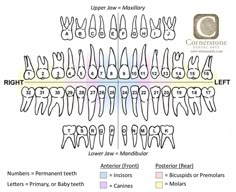

Primary supernumerary tooth numbers add an S (tooth A = AS). Permanent supernumerary tooth numbers add 50 to the tooth number (tooth 1 = 51). For supernumerary teeth, valid values are 51-82 and AS-TS. Universal (Common in the United States, 1-32): Valid tooth numbers are 1-32 and A-T.Tooth Numbering: The default numbering system is set in Preferences, Tooth Nomenclature.Open Dental supports 4 different tooth numbering systems: Drag the slider bar under the chart to show procedure changes to the tooth chart over time. Click and drag to quickly select multiple teeth. This chart visually shows the patient's teeth, as well as treatment that has been performed, is planned, or has been referred out. Tooth number 13 is the longest tooth, so its hygiene needs to be maintained regularly.In the Chart Module, at the upper left, is the graphical tooth chart.According to the universal numbering system, mention the names of these teeth. Plaque readily accumulates on the lingual surfaces of teeth #22 to #27 and can be washed away with smart toothbrushes. Dental plaque is a house of bacteria and is a root cause of gum diseases.According to the FDI system, what numbers are assigned to wisdom teeth (third molars).
TEETH CHART DENTIST MANUAL

The use of “hashtag” before each number sets them apart from other numbering systems. This system is also in the clockwise direction, but different numbers are assigned to different teeth this time. This system is widely used in the United States of America (USA). For example, tooth 63 means Upper left canine. Instead of 1,2,3,4 quadrants are numbered as 4,5,6,7, and the numbers of the individual tooth are from 1 to 5 (4 and 5 being the 1 st and 2 nd molar). In the case of primary teeth, the method remains the same only the numbers are changed. Similarly, if we say tooth number 24, we’re referring to the Upper left second premolar. If we say tooth number 13 is the problematic one, we are referring to the Upper right canine.

Like quadrants, individual teeth are also assigned a set of numbers. Starting from the left side of the patient, examining the mouth in the clockwise direction, all the numbers fall in place systematically. For an adult’s teeth, the quadrants have the following numbers įor ease of learning, imagine yourself as a dentist examining a patient. It consists of 2-digit numbers, the first being the quadrant and the second being the tooth. This numbering system is widely used in Canada and is recommended by World Health Organisation (WHO). The three most commonly used numbering systems worldwide are the FDI system, the Universal numbering system, and the Palmer notation system. These numbering systems label quadrants in their own way. There are different numbering systems used in different parts of the world. These are Įach quadrant starts from the front incisors to the last molar teeth. In the world of dental professionals, your mouth is divided into four quadrants.

W hat kind of tooth is tooth 13 ? By the end of this article, you’ll know the numbers assigned to each tooth so that the next time you hear a dentist talking about numbers, you’ll know which tooth he is referring to. It can cause anxiety or confusion, especially if you cannot understand what numbers they are talking about. Sitting on a dental chair, listening to the words of the dentist and the assistant, is no joke. We cannot understand God’s plan, but we sure can understand the first step of dentist’s plan.


 0 kommentar(er)
0 kommentar(er)
